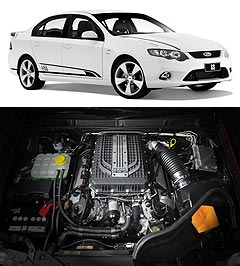Ford still agonising over Falcon XR8 engine
BY JAMES STANFORD | 7th Oct 2010

The company stopped building the XR8 in January, and the earliest a new version could go on sale is next July.
However, the re-appearance date could even stretch into 2012 depending on which way Ford decides to go.
GoAuto sources have revealed that while Ford Australia is committed to continuing with the popular nameplate, it is yet to lock in a decision on which engine will be under the bulging bonnet.

Just a few months ago, Ford considered taking the Ford Performance Vehicles GS – with its new Coyote-based supercharged V8 – and releasing it as an XR8.
It was finally decided to proceed with the original plan to release that model as the entry level FPV below the more powerful GT.
Ford Australia can still take a slightly de-tuned version of the new 5.0-litre supercharged ‘Miami’ V8 for the XR8 from its tuning partner FPV, which is a joint-venture between Ford and Prodrive.
The other option is to take a naturally aspirated version of the US-made Coyote V8, on which the new supercharged Miami engine is based.
Fitting a new engine into an existing car, calibrating, testing and putting it through all the internal hoops of Ford’s product quality program is not a fast process, and an 18 month timeframe is the best case scenario.
Either way, it is likely that FPV would do much of the engineering work, given its expertise with V8s and its in-depth knowledge of the Coyote engine. Ford Australia engineers are also flat-out with the new liquid injection LPG Falcon program, the EcoBoost four-cylinder Falcon, diesel Territory and the T6 SUV global development project.
Ford Australia president Marin Burela this week assured Ford fans that the XR8 would not be chopped from the line-up.
“We have an incredible desire to not let go of things that actually work for us,” he said.
“The XR8, all I can say is stay tuned, it is very much a part of the Ford line-up and it will be for many, many years to come. We are working on some exciting things.” Mr Burela said Ford Australia felt that bringing out an XR8 at the same time as the new FPV range, the Ford Focus RS, the reveal of the next Ranger at this month’s Australian International Motor Show would have meant it would have struggled for the attention it deserved.
“We thought it was the right thing to do to bring out the FPV range first, to get that established and moving,” Mr Burela said.
“Without going through the process of crowding the information out there too much, we have the motor show, and for the XR8 coming out at the same time, we thought, ‘you know what, we need to do this in a very well-managed way’.” The XR8 was phased out in line with the end of production of the 5.4-litre Boss V8, which was not going to meet the July 1 Euro 4 emission standards.
FPV built the Australia-only engine at its Campbellfield plant with a range of products from various vehicles. The cast-iron block was from the F-Series truck, the four-valve heads came from a Cobra R Mustang and many components, including the pistons, were sourced locally.
The new supercharged Boss V8 uses a wide range of Mustang Coyote V8 parts, but also some unique parts from the US as well as a range of locally sourced parts.
A naturally aspirated version of the Coyote would be a cheaper and easier option as it could be imported largely complete from North America, although local engineering costs would have to be factored in.
The last XR8 didn’t make a huge contribution to Ford Australia’s sales tally, but was an important part of Ford’s sporty brand image.
With FPV vehicles no longer wearing Blue Oval badges and instead featuring FPV logos, the brand building role of the XR8 has never been more important.
Sales of XR8 sedan and ute stood at 4083 in 2005 before dropping to 2152 in 2006, 1470 in 2007 and 1542 in 2008 before steadying at 1577 in 2009. The end of production early in the year has meant just 610 XR8s have been sold this year.